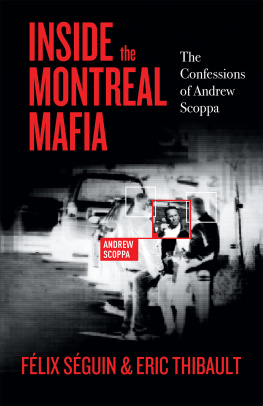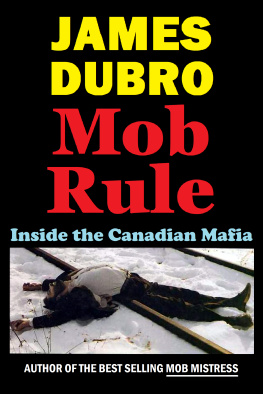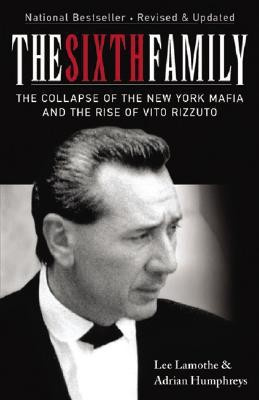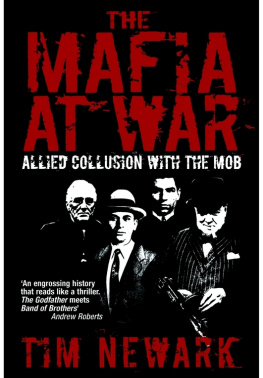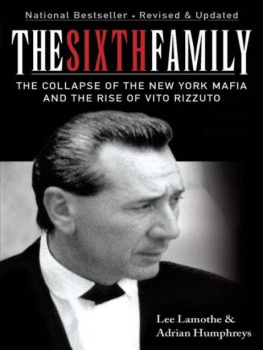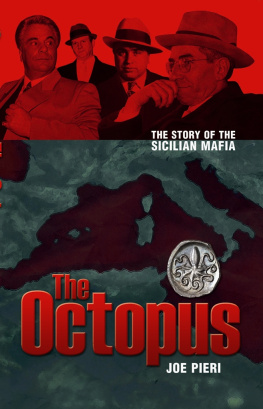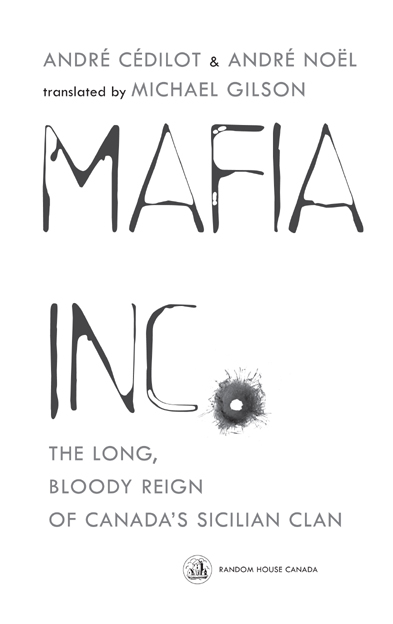PUBLISHED BY RANDOM HOUSE CANADA
Copyright 2010 Les ditions de lHomme, a division of Sogides Group Inc.,
a subsidiary of Quebecor Media Inc.
English Translation Copyright 2011 Michael Gilson
All rights reserved under International and Pan-American Copyright Conventions. No part of this book may be reproduced in any form or by any electronic or mechanical means, including information storage and retrieval systems, without permission in writing from the publisher, except by a reviewer, who may quote brief passages in a review. Published in 2011 by Random House Canada, a division of Random House of Canada Limited, Toronto. Previously published in Canada in French by Les ditions lHomme. Distributed in Canada by Random House of Canada Limited.
www.randomhouse.ca
Random House Canada and colophon are registered trademarks.
is a continuation of this copyright page.
Library and Archives Canada Cataloguing in Publication
Cdilot, Andr
Mafia Inc. : the long, bloody reign of Canadas Sicilian clan / Andr Cdilot and Andr Nol ; translated by Michael Gilson.
Translation of: Mafia inc.
eISBN: 978-0-307-36042-7
1. MafiaQubec (Province)History. I. Nol, Andr, 1953
II. Gilson, Michael III. Title.
HV6453.C3213Q8 2011 364.10609714 C20119017369
The translation of this book was assisted by a grant from the Government of Qubec (SODEC).
Cover images: (Nicol Rizzuto) THE CANADIAN PRESS / Montreal La PresseAlain Roberge; (bullet hole) Photodisc/Punchstock
Cover design: Andrew Roberts
Where the authors had access to English-language documents only through versions already translated into the French, those documents appear in this book having been translated back into English
v3.1
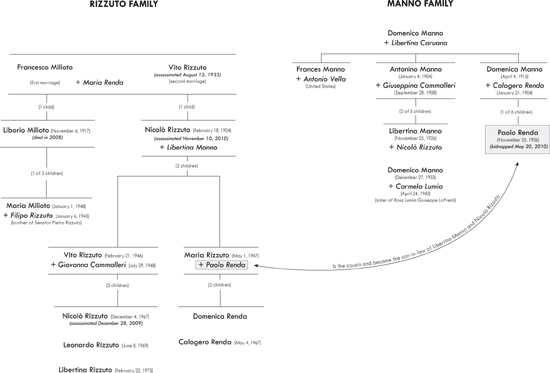
CARUANA FAMILY
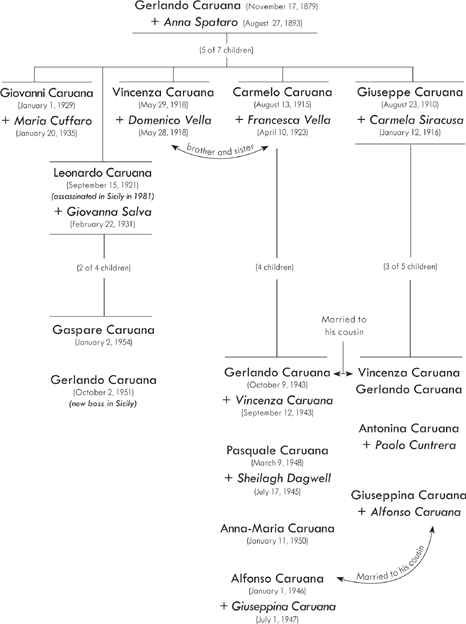
CUNTRERA FAMILY
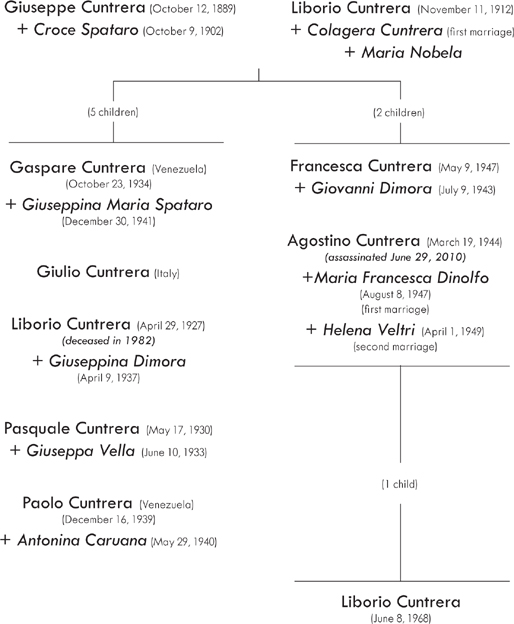
FOREWORD
Y OU HAVE NO IDEA what Mafia means? the president of the Commission denqute sur le crime organis ( CECO , the Quebec Police Commission hearings into organized crime) asked Pietro Sciara in November 1975, as part of the commissions investigation into the criminal activities of Montreals Cotroni organization. No, Sciara replied matter-of-factly.
The Sicilian mobster made that denial despite incontrovertible evidence, provided by electronic surveillance, that he had played a crucial role some years earlier in the conflict between Paolo Violi, then the number two man in the Montreal Mafia, and one Nicol Rizzuto. Well aware that he had incriminated himself on tape, Sciara preferred to seek the refuge of omert, the famous code of silence. Three months later, in February 1976, he was coldly gunned down as he left a movie theatre. The Mafioso had paid with his life for failing to support his Sicilian compatriots.
It was thanks to the televised CECO hearings that people in Quebec and the rest of Canada first learned about Sicilian Mafiosimen like Nicol Rizzuto, Domenico Manno, Giuseppe LoPresti and Leonardo Caruana. Quebecers knew, of course, how the Cotroni brothers, Vincenzo and Frank, had ruled the Montreal underworld for decades; their deeds often made the front pages. Testimonies at the CECO , however, revealed that the Montreal family in fact comprised not one but two distinct clans: the Calabrians, led by Vincenzo Vic Cotroni, who were from Italys mainland, and the Sicilians, who had emigrated from the towns of Siculiana and Cattolica Eraclea, in the province of Agrigento. They had come to Canada between the mid-1950s and mid-1960s, and their organization had branches in South America and the United States.
No criminal charges were laid as a result of the CECO investigation. But its explosive revelations were devastating for the Calabrian clan; the police wiretaps and bugs had brought to light the serious rifts between Montreals Calabrian and Sicilian Mafiosi. The resulting strife would lead to a bloody denouement, with a series of settlings of accounts that culminated in January 1978 with the dramatic execution of Paolo Violi. A changing of the guard had taken place within the Montreal Mafia, heralding a new era: the reign of the Rizzuto family.
The structure and operations of organized criminal activity in Montreal have changed a great deal since the 1940s, a time when the city teemed with brothels, gambling houses and dives, under the complacent eyes of the municipal authorities. Beginning in the 1950s, American mobsters moved in and took over the action. With Carmine Galante, an influential member of the infamous Bonanno family of New York, at its helm, the Montreal Mafia truly began to organize. They stepped up their supervision of the gambling joints and institutionalized that protection racket in every nightclub and restaurant. When the American gangsters began to focus specifically on heroin trafficking, Galante seized the strategic importance of Montreal: it was close to New York, with extensive port facilities that made it a perfect hub linking Europe with the major cities of the Eastern Seaboard. The Cotroni clan, already well entrenched, would serve as the bridgehead between the drug producers of Corsica and Marseilles and the huge market of users in New York, making Montreal one of the worlds most important waypoints for narcotics at the time. But the Sicilians in the shadow of the Cotroni clan, including Nicol Rizzuto and the members of the Cuntrera-Caruana family, also grasped the magnitude of this lucrative racketand they were not about to sit by and let the Calabrians keep the biggest piece of the action to themselves.
After the turmoil of the 1970s and a period of forced exile in Venezuela, the Rizzutos, father Nicol and son Vito, returned to Montreal in the early 1980s. From then on, under their command, the Montreal Mafia began a radical, unforeseen expansion. Under the aegis of Vito Rizzuto, with the benefit of his fathers experience and advice, criminal activity in the city was organized like a business. Before long, large-scale drug trafficking would propel the Sicilian organization to the top of the underworld pyramid and a leading role on the mob scene in Canada and around the world. Wielding charisma and possessed of considerable skills as a mediator, Vito Rizzuto quickly won the unanimous backing of those around him and the respect of the bosses of other local criminal organizations. He surrounded himself with informed advisers and criminals, and the organization achieved complete control over its territory.
Men come and go, but institutions and their structures abide. This has been the key to the strength and renown of Cosa Nostra for more than a centuryand it is doubtless true of the Rizzuto organization. Deploying its organizational model inspired by the Sicilian crime families, over the years the family implemented a system of alliances among the dozen or so clans making up the Montreal Mafia, and in so doing has consolidated its authority and made police infiltration difficult.


